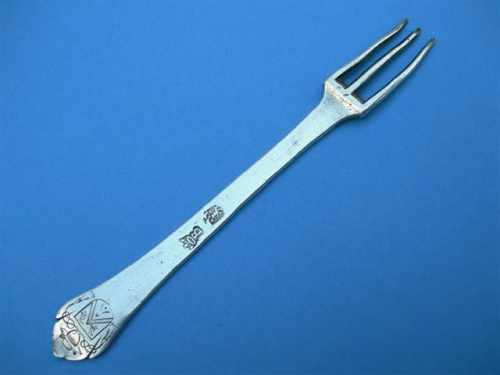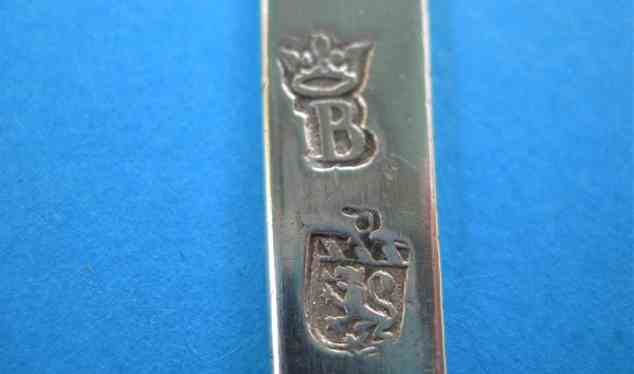(click on photos to enlarge image)
A BURGUNDIAN FORK DATED 1660
During a recent auction, it was my pleasure to appraise the
fork represented above. The fork was produced about 1660 in the
town of AUTUN in Burgundy (of which the capital is DIJON).
AUTUN
Today Autun is a small town of 16500
inhabitants. Autun was, during the seventeenth
century, an important bishopric.
The source of the largest orders, at the time of
this fork's making, was the bishopric for its needed
religious pieces.
Since 1647, the Autunian silversmiths has been
regulated by the guild of Dijon. The average number
of silversmith workshops was five during the
seventeenth century. Their number remained close to
five and was not much reduced until the eighteenth
century. In 1759 the number had declined to one.
|
 |
THE FORK AND ITS OWNER
The fork appears in France in the middle of the seventeenth
century. It originally had 3 teeth, and was probably not used to
carry food to the mouth, but at the most to pick food up. The
fourth prong added to the three precedents will give the fork
its final form at the beginning of the eighteenth century.
This original model of
fork is completely flat, without the least curve
One notes a shoulder close to the tines on the stem.
The handle has no shoulder.
The fascination of the object presented here lies in
this handle, slightly widened and ending in a form
called "dog-nose"; slightly raised at its end.
|
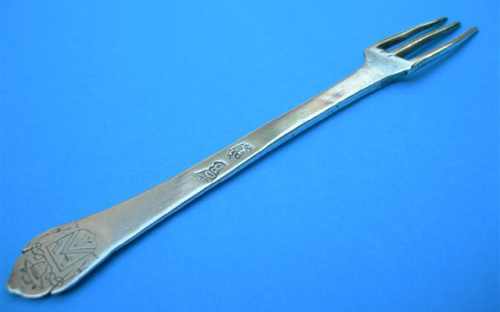 |
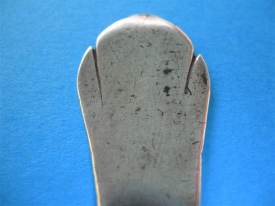 |
The spatule ending in a form called "dog-nose"
(left)
Prongs in poor state
(right)
|
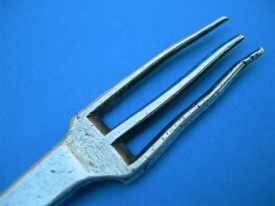 |
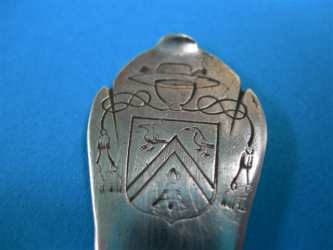 |
The contemporary armorial engraved on the
spatula indicates that the owner of the fork is the
bishop of the city.
There is no evidence that the latter had more than
one specimen of such an item, at most can one
imagine that the bishop placed an order for what one
then called a "service set", i.e. a unit made up of
a fork and a spoon (described today as a "cover").
The spoon which should accompany the fork would
commonly at that time have been with a "rat-tail"
(see picture on bottom page)
|
HALLMARKS DETERMINING THE AGE OF THE FORK
The marks are very well struck on the fork and very well
preserved, one easily distinguishes thus:
- a B under blossomed crown known as "open" (or princely),
characterizing the community of the silversmiths of AUTUN for
one period considered ranging between 1656 and 1680. This mark
is at the same time a warranty for solid silver alloy and
fineness;
- a P surmounting a shield with the weapons of the town of
AUTUN, thus described: "with the lion crawling with the chief of
Burgundy, of gold with 3 bands of azure " (see Remarks), which
is the mark of the goldsmith Claude POMMIER, first registered in
1660, deceased in 1680 (its widow will take again the workshop
until 1729).
REMARKS
- as from the seventeenth century, most of the silversmiths
living in the Burgundian cities stamped the first initial of one
of their names above or below the armorial bearings of their
city. This practice continued until the French revolution of
1789.
Claude POMMIER?s mark has never been reproduced in a previous
work, it was simply described, without absolute certainty
concerning the positioning of the initial "P" of the Master. The
image above confirms the mark and constitutes a discovery.
- the lion appearing in the shield is a heraldic symbol and, as
such, it is known as "crawling" in this position,? while at the
same time it is proudly drawn up on its rear legs!
- the fork has no other marks and in particular, for dating
purposes, does not have a tax punch. Since 1672 Louis XIV
obtained to impose a tax on silver and gold items in all his
kingdom and in 1677 a tax punch was introduced in AUTUN to show
the payment of this tax.
Following this reform, the tax collector ("fermier général")
struck silver objects with one (and later 2) marks proving the
payment of the tax. The first punch brought into service in
AUTUN in 1677 is a form of a P crowned in an oval. The fork, not
having this mark, was manufactured there before this year.
Eventually, one can thus estimate that the fork was produced
during one period ranging between 1660 (initial registration
date of the silversmith) and 1677. Maybe one could further
reduce this interval using the armorial bearings of the bishop
engraved on the object (for example if the ecclesiastic had
taken his office after 1660).
- the price of adjudication recorded at the time of this auction
was of 1275 euros (1874 USD). A performance which could have
been much higher, still, if the prongs had been presented in a
better state for such a museum piece.
DESCRIPTION
- Length = 17 cm,
- Width measured at the level of the prongs = 2 cm,
- Weight = 39 grams.
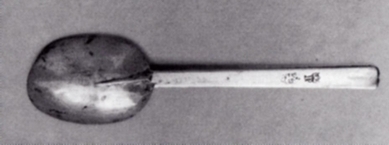 |
Spoon with "rat-tail" on the bowl
Autun, about 1650
|

www.silvercollection.it |
This is a page of A Small Collection of
Antique Silver and Objects of vertu, a 1500 pages richly illustrated website offering all you need to know about
antique silver, sterling silver, silverplate, Sheffield plate, electroplate silver,
silverware, flatware, tea services and tea complements, marks and hallmarks, articles,
books, auction catalogs, famous silversmiths (Tiffany, Gorham, Jensen, Elkington),
history, oddities ...
HOME - SITE MAP - SILVER DICTIONARY - COOKIES CONSENT AND PRIVACY
OTHER ARTICLES ABOUT: ANTIQUE SILVER
SILVER PLATE
ENGLISH SILVER
FRENCH SILVER
|
|
|
|


